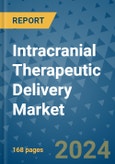The global intracranial therapeutic delivery market is poised for unprecedented growth. According to a comprehensive market analysis, the sector, valued at US$ 2.2 billion in 2024, is projected to burgeon at a compound annual growth rate (CAGR) of 9% over the next decade, culminating in a staggering US$ 4 billion by 2031. This surge reflects the increasing demand for innovative treatments in neurology and the rising prevalence of neurological disorders worldwide.
Moreover, a tangible shift towards regenerative therapies over conventional drug-based treatments is reshaping the landscape. These advancements, coupled with supportive government policies, especially in emerging economies, herald a new era of healthcare possibilities.
This product will be delivered within 1-3 business days.
Intracranial Therapeutic Delivery: A Pillar of Regenerative Medicine
Accounting for approximately 6.1% of the global regenerative medicine market in 2021, intracranial therapeutic delivery stands at the forefront of transforming patient care. With a significant emphasis on cell, gene, and enzyme replacement therapies, this sector promises a new dawn in the treatment of a myriad of conditions, offering hope where traditional modalities fall short.A Decade in Review: Triumphs and Innovations
The period from 2018 to 2023 has witnessed a notable ascent in the popularity and efficacy of intracranial therapeutic delivery methods, especially in the realms of cell and gene therapy. This paradigm shift, underpinned by extensive research and collaboration among biopharmaceutical giants such as Bristol Myers Squibb, Gilead Sciences & Company, and Xcell Biosciences Inc., underscores a transformative approach to disease management and prevention. The pursuit of excellence by these key players, through strategic acquisitions and partnerships, is setting new benchmarks in the industry.Market Drivers: A Confluence of Innovation and Opportunity
The market's trajectory is notably influenced by the burgeoning pipeline of cell, gene, and enzyme replacement therapies, which account for a substantial portion of the pharmaceutical industry's research focus. With over 750 trials and more than 200 investigational new drug applications anticipated by the U.S. FDA, the sector is on the cusp of delivering groundbreaking treatments to patients across the globe.Moreover, a tangible shift towards regenerative therapies over conventional drug-based treatments is reshaping the landscape. These advancements, coupled with supportive government policies, especially in emerging economies, herald a new era of healthcare possibilities.
Challenges and Constraints: Navigating Through Uncertainties
Despite the optimistic outlook, the market faces hurdles, primarily due to the high costs associated with these advanced therapies. The financial implications for patients and healthcare systems, along with a lack of comprehensive reimbursement policies, present significant challenges. Addressing these concerns is crucial for ensuring the accessibility and sustainability of intracranial therapeutic delivery methods.Geographical Insights: Key Markets and Emerging Players
- United States: Leading the charge with a 36.4% market share, the U.S. is a hotbed for R&D, bolstered by robust government support and regulatory frameworks.
- Germany: With a quarter share of the European market, Germany's robust healthcare expenditure and thriving biopharmaceutical landscape make it a key player in the sector.
- United Kingdom: The U.K.'s commitment to regenerative medicine and its significant contribution to the European advanced therapeutic medicinal products (ATMP) sector underscore its pivotal role in the market's growth.
- South Korea: Demonstrating rapid progress, South Korea's strategic investments in biopharma and biotech are unlocking new possibilities in intracranial therapeutic delivery.
The Competitive Landscape: Fostering Innovation and Collaboration
The market's future is shaped by strategic collaborations, mergers, and acquisitions among leading firms. Innovations and product launches are critical for maintaining competitive advantage and addressing the evolving needs of patients worldwide. Notable developments, such as ElevateBio's lentiviral vector production platform and the collaboration between Biogen and Ginkgo Bioworks, highlight the industry's commitment to revolutionizing intracranial therapeutic delivery.Key Companies Profiled
- Novartis AG
- BioMarin
- CORESTEM Inc.
- Alaunos Therapeutics, Inc.
- Apic Bio
- Stemedica Cell Technologies, Inc.
- Voyager Therapeutics
- Bayer AG
- Abeona Therapeutics
- Spark Therapeutics
Segmentation of Intracranial Therapeutic Delivery Industry
Intracranial Therapeutic Delivery Market by Therapy:
- Cell-based Therapy
- Gene Therapy
- Enzyme Replacement Therapy
Intracranial Therapeutic Delivery Market by Indication:
- Spinal Muscular Atrophy (SMA)
- Multiple Sclerosis
- Batten Disease
- Amyotrophic Lateral Sclerosis
Intracranial Therapeutic Delivery Market by Region:
- U.S. Intracranial Therapeutic Delivery Market
- Europe Intracranial Therapeutic Delivery Market
- Rest of the World (ROW) Intracranial Therapeutic Delivery Market
This product will be delivered within 1-3 business days.
Table of Contents
1. Executive Summary
2. Market Overview
3. Global Intracranial Therapeutic Delivery Market Outlook, 2018 - 2031
4. North America Intracranial Therapeutic Delivery Market Outlook, 2018 - 2031
5. Europe Intracranial Therapeutic Delivery Market Outlook, 2018 - 2031
6. Asia Pacific Intracranial Therapeutic Delivery Market Outlook, 2018 - 2031
7. Latin America Intracranial Therapeutic Delivery Market Outlook, 2018 - 2031
8. Middle East & Africa Intracranial Therapeutic Delivery Market Outlook, 2018 - 2031
9. Competitive Landscape
10. Appendix
Companies Mentioned
- Novartis AG
- BioMarin
- CORESTEM Inc.
- Alaunos Therapeutics, Inc.
- Apic Bio
- Stemedica Cell Technologies, Inc.
- Voyager Therapeutics
- Bayer AG
- Abeona Therapeutics
- Spark Therapeutics
Methodology

LOADING...








